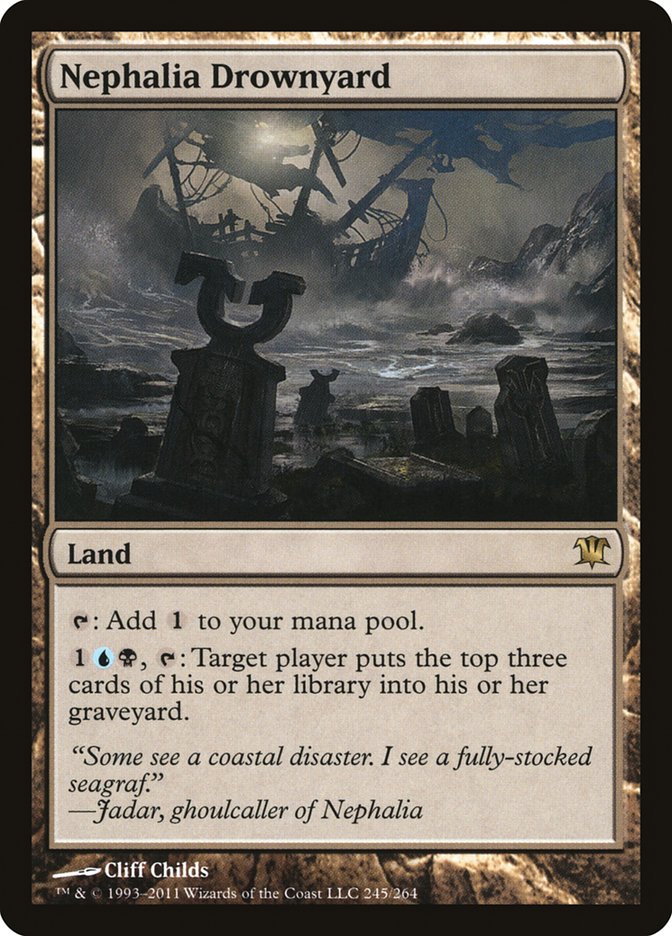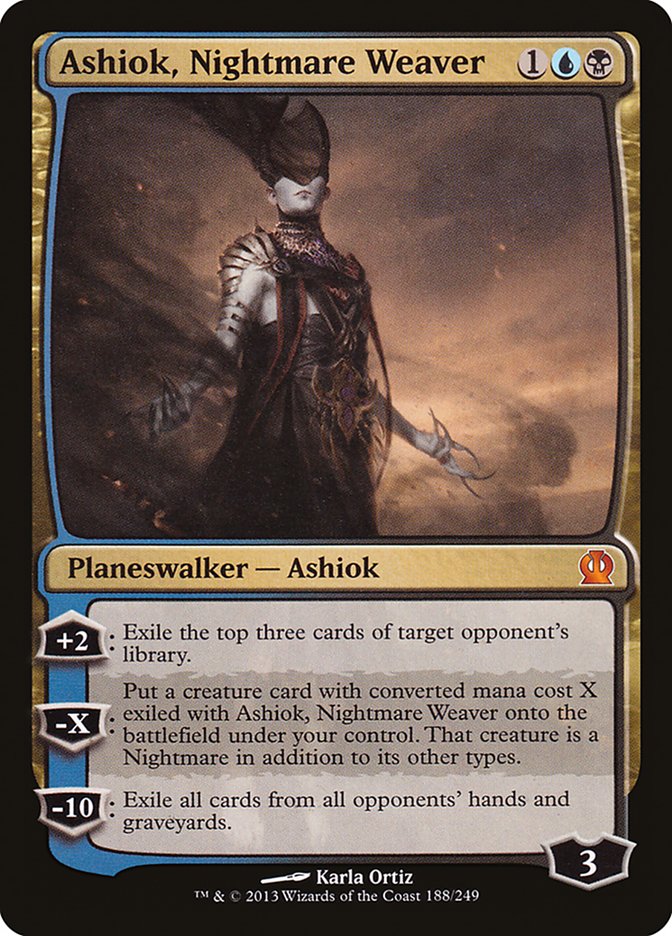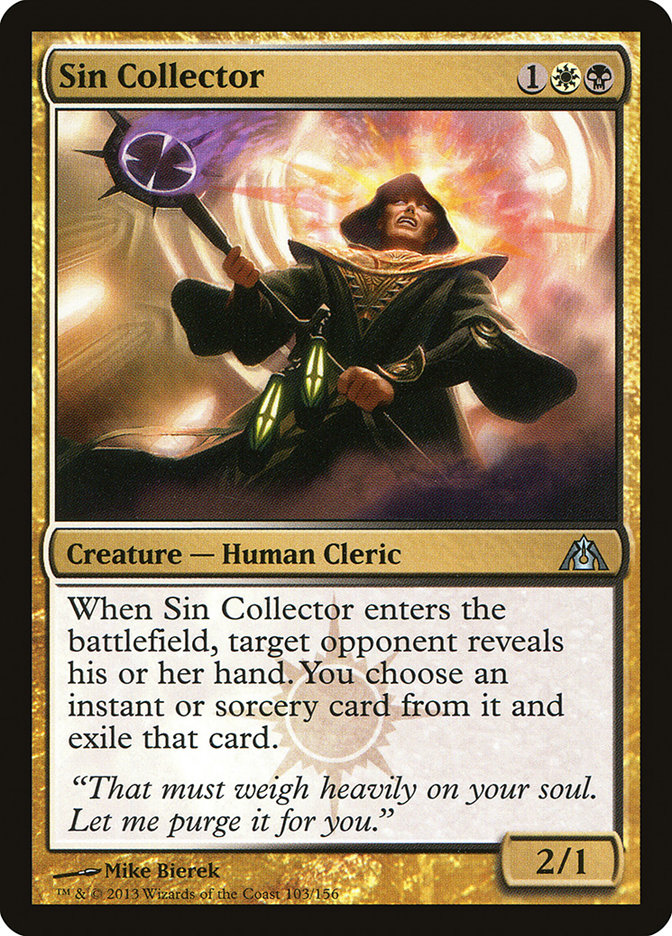A few weeks of testing has given me additional insight into the Standard format and U/W/R. As predicted, U/W/R has performed very well against the aggressive decks and I have been able to outmaneuver Esper control with a few bombs out of the maindeck and sideboard. The Esper plan of Ashiok, Nightmare Weaver is not only a weak one but applies no real threat of milling or retrieving one of your monsters to battle against you. Ashiok, Nightmare Weaver through testing has been nothing more than a nuisance — a singleton Drownyard effect that can be played on turn three and still yield a loss for the Esper mage.
This article is going to attempt to accomplish a few things. I’m going to start off by talking my readers and friends out of playing Ashiok in their control builds, just like I tried to do with Omenspeaker. I’m not the kind of guy who trashes a card in a deck that I’m not even playing, so I’m going to then provide you guys with an Esper list that I have together if you decide to go that route. Finally, I’ll put out the latest form of U/W/R and give a brief explanation on the weaknesses and strengths associated with the choice of red over black.
Don’t play Ashiok!
I have friends, including many of you, that still pick on me about Preordain. It’s true that for a good amount of time I was an advocate against playing Preordain in U/W Control. I narrowly lost to Christian Calcano in the finals of a Standard Open and also lost my win-and-in at the last U.S. Nationals with Preordain-less U/W Control, finishing in the Top 16. After some logical thought, I probably could have won both of those events if I did play Preordain and yes — I was wrong.
This isn’t Preordain.
I advocated for readers to pick up $1 Consecrated Sphinxes, for the power of Jace Beleren, and for many other control superstars, so I have some credibility. Consider this my official apology for Preordain — Chapin will be happy.
Now let’s move on!
After playtesting Esper, watching the Pro Tour coverage and just using some common sense, I’ve come to the conclusion that Ashiok, Nightmare Weaver is a three-drop do-nothing against aggressive decks. The planeswalker comes down, jumps loyalty, and then sits on the board as you die to creatures. Let’s break down why you should leave this ‘walker at home.
Bad Against Aggro
Ashiok’s loyalty is a distraction that will be ignored. A three-drop planeswalker that jumps to five loyalty definitely caught my eye at first. It comes in, mills three, and then sits back as you face down creatures in the early turns. The biggest issue prior to Ashiok resolving in game one is that you do nothing in the early turns. Nine out of ten times you have to shock yourself on turn two to cast Doom Blade or Azorious Charm, if you even have it, which means the follow-up play on turn three needs to impact the board in a big way.
These aren’t the old days of the Wild West where you could just pace backwards as your opponent walked into a turn-four Wrath of God. Creatures are more powerful than they have ever been, and they are going to keep to that power level until the end of this game. Because of the power level of creatures, Magic as a whole has improved in support and popularity, so we have to get used to it. That being said, Ashiok doesn’t do anything to the board upon arrival and that makes it inherently bad against aggressive decks.
Not good against control
At first glance, this planeswalker appears to have a control-hating vibe.
It doesn’t.
The average control deck has between zero and four creatures in the maindeck, and without the hope of providing a threat Ashiok is no more than a legendary Nephalia Drownyard. Nephalia Drownyard was good because you could play it early without fear of counterspells or a Hero’s Downfall, and it couldn’t be attacked or Detention Sphered. Most importantly of all, you could have multiples going to town from the middle of the game to the end. The chances of Ashiok milling your control opponent out on its own is ludicrous. A Drownyard always knew another one was on its way at any point, and when it arrived no counterspell, no army of creatures, and no spell could touch it. The best part about Drownyard is that it required zero spell slots and fit right into the perfect three-color manabase of old.


Ashiok drops on turn three in perfect world and starts doing its thing right away. You mill and you mill and you pray that an ultimate can snag an opponent’s entire hand with ease. How often does that happen? The answer is close to zero. The ultimate is so far away even at the +2 speed of the first ability, and by then either your hand is empty from playing much bigger and better threats/planeswalkers or by then you drop a Detention Sphere/Dreadbore/Hero’s Demise on the over-hyped walker. In testing and in queues on MTGO, I have defeated Esper with U/W/R and my own Esper deck multiple times while their Ashiok was on the board. The control matchup boils down to bomb creatures and Jace, Memory Adept — not Ashiok, which will fall just short of closing the deal.
Some of you know this already about Ashiok, and even the great Wafo-Tapa knows the truth. Wafo-Tapa lost zero matches in the Swiss of the Pro Tour and had zero Ashioks between his maindeck and sideboard. Use the Memory Adept and some Aetherlings backed up with a ton of counterspells if you want victory in the control mirror.
If it misses, it gets even worse
The above descriptions are when the planeswalker works optimally. Sometimes cards don’t do what they are supposed to do, and then bad things happen. Ashiok’s first ability is exiling three cards and then creatures exiled that way can be acquired for loyalty. Against aggro or midrange you sometimes miss on the first try and then you have to waste an entire new activation with the hope of hitting a creature. You simply don’t have that kind of time in Magic!
Any aggro player will know to ignore the feeble planeswalker and continue to bash your face in while you hope one day to put a Rakdos Cackler in play. Against control you mill and you mill hoping to one day land an Aetherling or Obzedat, but how good are those anyway? You can’t use their abilities and they can just waste one of those dead removal spells they’ve been holding the entire game. When Ashiok mills the perfect Boros Reckoner at the perfect time it is still just decent, and other spells in the same slot would accomplish a similar effect… but when it doesn’t work that well it becomes a liability control just doesn’t need.
So you wanna play Esper?
Fine! Let’s build an Esper deck. One just made the Top 8 at PT Theros and our list will be similar, but this deck was made and tested prior to Wafo-Tapa’s finish. Upon the release of Theros I felt (and still feel) that U/W/R has more tools to deal with most of the new aggro decks crawling out of the woodworks. This doesn’t mean U/W/R is better, because Esper offers help against planeswalkers and midrange decks that U/W/R has a hard time with.
Esper has the ability to dispatch Stormbreath Dragons with an arsenal of black removal spells, while U/W/R has just the sweepers and Elspeth, Sun’s Champion to do the trick in game one. Planeswalkers from the G/R Monsters deck as well as the control mirror are also handled by Hero’s Downfall in a much easier fashion. U/W/R has to get creative and use burn, counters, and Detention Sphere as their last line of defense. The control mirror is still a coinflip. If people continue to run Ashiok as their “control killer” in Esper, then I still feel that Assemble the Legion, Counterflux, and our Jace plan is superior.
Esper’s control dominance will continue because of recent successes in both the Pro Tour and the Open Series. When a deck performs well, it definitely gains momentum and will be a force to be reckoned with for at least a month or two. Esper has all the tools to defeat decks across the board, but the true weakness lies in the red aggressive decks that happen to be as or more popular in the current metagame. Cards like Pharika’s Cure are a must-have in the sideboards to help offset the life loss, and you’ll need one or two Last Breaths to deal with Chandra’s Phoenix and other quick threats from the red menace. Winning game one depends on poor draws by the opponent or a perfect series of removal spells into an Obzedat, Ghost Council… or some other way to win quickly before having the final few points of burn aimed at your face.
The Esper matchups from other aggro types are also a bit rough. Cards like Burning Earth are killers because the answers are few and far between in Esper. I’m all for tossing a Wear/Tear in the sideboard of U/W/R as a great, cheap answer to that and Hammer of Purphoros from the red-based decks. Against G/W decks, Esper has to utilize cards like Last Breath and Glare of Heresy to remove pesky creatures from the game. U/W/R has the ability to drop an Anger of the Gods to clear the world of those problem creatures instead of being forced to one-for-one them repeatedly. These are a few reasons why Esper has a tougher time against the aggressive field, but where there are cons there are also pros.
Esper’s matchup against the control decks has the advantage on paper. Cards like Hero’s Downfall, Thoughtseize, Sin Collector, and Obzedat, Ghost Council are all cards that have crowned Esper king of the hill in the control-versus-control universe. I have had great success defeating Esper on the back of Assemble the Legion, but that strategy will not work forever. Once Esper players start jamming multiple Jace, Memory Adepts and an array of counterspells between main and board, the U/W/R decks will have a rough time gaining traction. Sin Collector and Obzedat, Ghost Council are just nightmare cards that require a ton of resources to dispatch. You can Far/Away Obzedat, but wasting a Hero’s Downfall on it might leave you vulnerable to a planeswalker that is just as bad or maybe even more devastating. Sin Collector is seeing some play in Esper, but it is easily the best card against the mirror match and many other control builds that enjoy high spell counts. When developing a gameplan and keeping hands with a Sphinx’s Revelation and a bunch of lands, cards that attack the hand can derail it in a heartbeat. Sin Collector in multiples can nearly kill an opponent with the clock attached to the disruption, because in the control mirror match you have to board out most of your removal — especially the sweepers.

If I were to switch to Esper for the Invitational, it would definitely be because of cards like Sin Collector and Thoughtseize that can just outclass any midrange or control deck that banks on the potency of its spells.
When battling against a midrange deck with Stormbreath Dragon, Esper is the weapon you want. U/W/R has very few answers to the pesky, hasted monster and needs to use cards like Supreme Verdict sparingly in order to have one in the chamber to deal with it. The full removal suite of Esper is black-based, with cards like Doom Blade, Far/Away, and Hero’s Downfall—you shouldn’t fear the wrath of Dragons. Esper also has the same stock answers in Supreme Verdict and Elspeth, Sun’s Champion, so a Stormbreath Dragon should never be an issue for you.
The planeswalkers in the midrange decks like G/R (Domri Rade, Xenagos the Reveler) provide a huge problem for control decks. When left unchecked, they can punish control opponents with constant threats and a very scary ultimate from Domri Rade. Esper wins the title of “planeswalker killa” with the use of Hero’s Downfall combined with Detention Sphere. The creatures are easily handled by sweepers and spot removal, and counterspells are also another line of defense against those troublesome planeswalkers.
So which do I play?
The biggest item to consider when deciding which deck to play is the state of your local metagame. On Magic Online, I battle against aggro nearly every round. For that reason, I will continue to play U/W/R and sweep the little dude army under the rug with better spot removal and sweepers.
If your local metagame is less aggro-centric or the tournament you plan on attending is the Invitational, then you must consider Esper as the likely candidate. Better players at Pro Tours or Invitationals historically tend to lean toward midrange or control decks. Wafo-Tapa chose to draw first against opponents and played maindeck Thoughtseize because of the likeliness of them playing a control deck. It may sound crazy, but the upper tier of Magic play is weighted with decks that don’t have Burning-Tree Emissary in their 75.
Play style is also important when deciding which deck to choose. U/W/R is a much different deck than Esper in the way it plays out. It has a more aggressive stance when going for victory with the inclusion of Warleader’s Helix and Assemble the Legion. It tries to win immediately after stabilization with these cards and punishes opponents who have no answer for the enchantment in their maindeck.
Most of the Esper players we’ve seen don’t even play the Aetherling in the main and rely solely on planeswalkers to finish their opponent. To them I say: Add the Aetherling to your main! With aggro as good as it is and Hero’s Downfall everywhere, you don’t have the luxury of banking on your two copies of Elspeth, Sun’s Champion and your two copies of Ashiok, Nightmare Weaver to finish the deed. Including at least one Aetherling gives you inevitability because of the complete lack of answers to the un-killable, control- evading powerhouse. Play style is a big issue with players picking up decks to battle with. Some are more adept at using burn as removal and playing the role of the aggressor compared to a more traditional Draw-Go style build. Give them both a shot and change a list or two to make it more conformed to your metagame and play style, then go win yourself a tournament!
I think control is the best it’s been in a while. You see evidence of this with the popularity of Esper at the Pro Tour and watching people play traditional U/W or my version of U/W/R with some success on a smaller scale. The surge of Mono-Blue Devotion is the reason why U/W/R and Esper will be major players in the current Standard. Even though Devotion didn’t Top 8 the Milwaukee Standard Open, it did finish in first, second, and third at PT Theros. The deck is super powerful and can burst out opponents, especially if they’re playing green or red. Master of Waves and Tidebender Mage are both four-ofs and provide an unfair advantage against any decks affected by the protection or lockdown effects.
Luckily for us, they are just completely awful against control. Master of Waves dies to everything, Tidebender Mage is a dud, Omenspeaker is embarrassing, Cloudfin Raptor is a joke, and I could keep going and going but you get the idea. These cards mentioned along with all the others in the deck are very good against the rest of the field, however. The key enemy of the devotion deck is Supreme Verdict, and with four of those in each control deck combined with Jace, Architect of Though — whose +1 shuts down an entire board — us control folk will have smooth sailing as devotion becomes more popular. Their Jace, a couple counterspells, Thassa, God of the Sea, and her Bident are the only problem cards that can put fear in the heart of control. When I say that control decks love the existence of devotion it doesn’t mean that it’s a bye, but the matchup is about as good as it gets. In Magic, nothing is absolute, but you will never see me complain when they drop a Judge’s Familiar on turn one.
Here are the decklists, my friends. Choose wisely and I’ll see you guys in Indianapolis for the Invitational!
Creatures (4)
Planeswalkers (5)
Lands (26)
Spells (25)
- 3 Doom Blade
- 4 Azorius Charm
- 4 Supreme Verdict
- 2 Detention Sphere
- 3 Sphinx's Revelation
- 1 Far
- 2 Read the Bones
- 3 Hero's Downfall
- 3 Dissolve
Sideboard

Creatures (2)
Planeswalkers (5)
Lands (26)
Spells (27)
- 1 Divination
- 2 Ratchet Bomb
- 4 Azorius Charm
- 4 Supreme Verdict
- 3 Detention Sphere
- 3 Sphinx's Revelation
- 2 Assemble the Legion
- 3 Warleader's Helix
- 2 Chained to the Rocks
- 3 Dissolve
Sideboard

